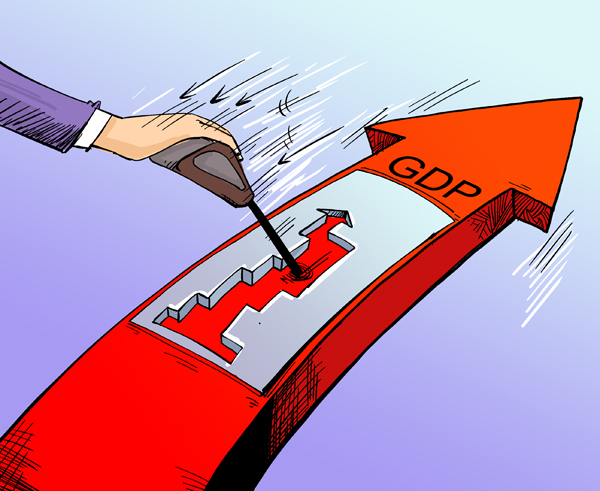Steady economic growth is the new normal
- By Liu Shijin
 0 Comment(s)
0 Comment(s) Print
Print E-mail China.org.cn, January 20, 2014
E-mail China.org.cn, January 20, 2014
The stable and good momentum of economic growth in recent months will ensure that China is able to fulfill its expected growth target. The question is how long this growth momentum can last. The consensus is that China’s economy is undergoing a transition from a high growth rate of around 10 percent to a relatively high and medium growth rate, but it is unclear where the bottom is. Given its unbalanced economic development, China’s average growth rate should not be too low, and it could be at 7 percent or between 6 and 7 percent.
|
|
|
Slow but steady [By Gou Ben/China.org.cn] |
The transition needs to be completed in one or two years, and then the growth can be stabilized. To be exact, we will know where the bottom is (say 7 percent) and it will be able to sustain for a relatively long period, say five or more years.
This state of economic growth should have the following characteristics. First, the high growth rate will gradually slow down to a new balanced growth rate, say 7 percent. Second, the economy will take on a new structure, with growth primarily coming from consumption, the service industry and domestic demand. Third, industrial upgrading and innovation has been expedited, pressure on resources eased and growth sustainability promoted. The accompanying rise in productivity will effectively offset the rise in cost. Fourth, economic growth will be able to create enough jobs, and industrial restructuring will adapt to a mix of human resources and capital. Fifth, enterprises will make a stable profit, government revenue and resident income will maintain a stable increase, and the size of the middle class will expand.
Chinese business profitability is an issue that is likely to be ignored. It is typical that these companies are profitable when the growth rate is high and that their profit rate drops along with the decline of the economic growth rate. Studies indicate that their profit and loss ratio will exceed 40 percent when economic growth rate is below 7 percent, as long as the profit-making mode remains unchanged. That means that nearly half of enterprises will make a loss. So, something must be done to alter the profit-making model so that most enterprises can be profitable when economic growth rate stays at 7 percent. This is the essential problem that needs to be solved in the transformation of economic development.
First, a developed East China has gradually adapted to the macroeconomic environment with a slower growth rate, which has already dropped to around 7 percent. With the accelerated restructuring of enterprises and stable development, economic operation quality and profitability of enterprises have greatly improved. With the elimination of some low efficient enterprises and the reduction of those making losses, most companies’ performance has improved. High-tech and new industries show that the good momentum of development and private investment has regained its vitality. PMI in East China is higher than that in central and western China.
Second, employment in China is stable. The demand for jobs is a bit higher than the supply. Our estimate shows that employment pressure will not be very prominent unless the economic growth rate is below 6.5 percent.
Third, the number of loss-making enterprises is decreasing. The growth rate of industrial added value has been at around 10 percent since May 2012, but the total loss accounts for 0.8 percent of the income from main business, lower than the average 1.4 percent since 1997, and also lower than the average 0.9 percent during the rapid growth period since 2003. This shows that most enterprises can maintain a normal production performance when the economic growth rate stays at 7 percent and the growth rate of industrial added value is at 10 percent.







Go to Forum >>0 Comment(s)